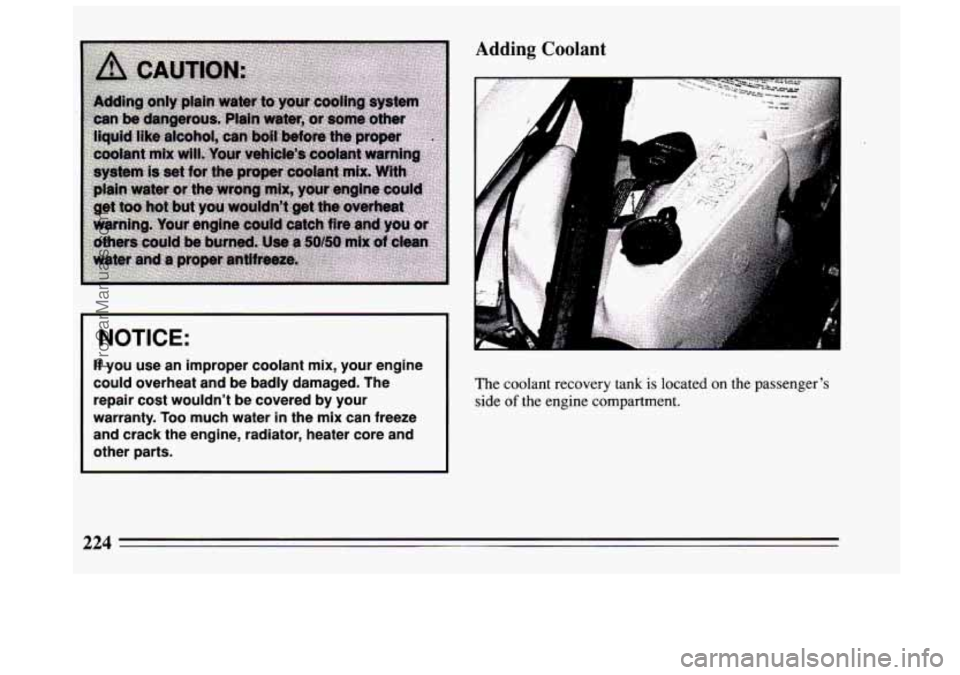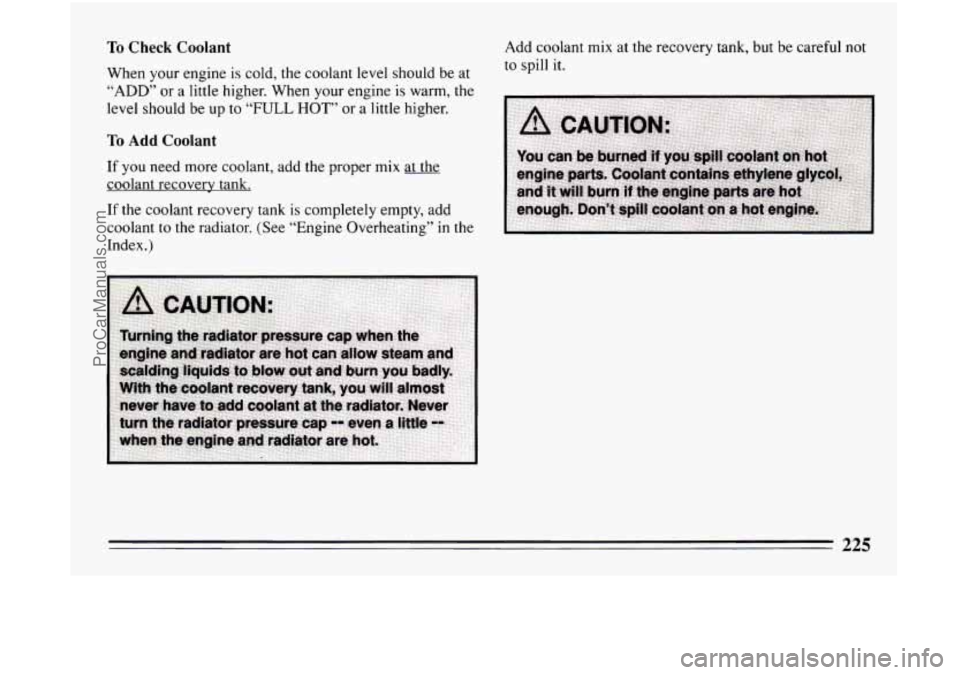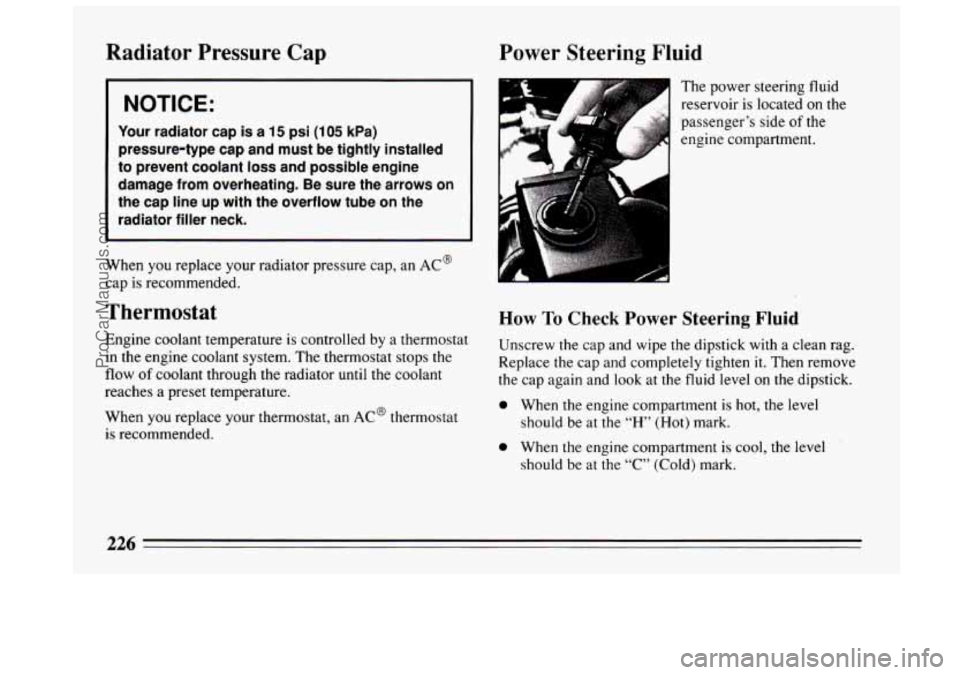1994 BUICK CENTURY engine coolant
[x] Cancel search: engine coolantPage 225 of 308

How to Add Fluid
Refer to the Maintenance Schedule to determine what
kind of transaxle fluid
to use. See “Recommended
Fluids and Lubricants” in the Index.
Engine Coolant
If the fluid level is low, add only enough of the proper
fluid to bring the level into the cross-hatched area on the
dipstick.
1. Pull
out the dipstick.
2. Using a long-neck funnel, add enough fluid at the
It doesn’t take much fluid, generally less than a pint
(OSL).
Don’t overfill. We recommend you use only
fluid labeled DEXRON@-I11 or DEXRON@-IIE,
because fluids with that label are made especially for
your automatic transaxle. Damage caused by fluid other
than DEXRON@-I11 or DEXRON@-IIE is
not covered
by your new vehicle warranty. dipstick
hole
to bring it to the proper level.
After adding fluid, recheck the fluid level as
described under “How to Check.”
0 When the correct fluid level is obtained, push the
dipstick back in all the way. The following explains
your cooling system and how to
add coolant when it is low. If you have a problem with
engine overheating or if
you need to add coolant to your
radiator, see “Engine Overheating” in the Index.
The proper coolant for your Buick will:
0 Give freezing protection down to -34°F (-37°C).
0 Give boiling protection up to 262 “F ( 128 “C).
0 Protect against rust and corrosion.
Help keep the proper engine temperature.
0 Let the warning lights work as they should.
What to Use
Use a mixture of one-half clean water (preferably
distilled) and one-half antifreeze that meets “GM
Specification 1825-M,” which won’t damage aluminum
parts.
You can also use a recycled coolant conforming to
GM Specification 1825-M with a complete coolant flush
and refill. If you use this mixture,
you don’t need to add
anything else.
223
ProCarManuals.com
Page 226 of 308

Adding Coolant
NOTICE:
If you use an improper coolant mix, your engine
could overheat and be badly damaged. The
repair cost wouldn’t be covered by your
warranty.
Too much water in the mix can freeze
and crack the engine, radiator, heater core and
other parts.
The coolant recovery tank is located on the passenger’s
side
of the engine compartment.
224
ProCarManuals.com
Page 227 of 308

To Check Coolant
When your engine is cold, the coolant level should be at
“ADD” or a little higher. When your engine is warm, the
level should be up to
“FULL HOT’’ or a little higher.
To Add Coolant
If you need more coolant, add the proper mix at the
coolant recovery tank.
If the coolant recovery tank is completely empty, add
coolant to the radiator. (See “Engine Overheating” in the
Index.) Add
coolant mix at the recovery tank, but be careful not
to spill it.
225
ProCarManuals.com
Page 228 of 308

Radiator Pressure Cap
I NOTICE:
Your radiator cap is a 15 psi (105 kPa)
pressure-type cap and must be tightly installed
to prevent coolant
loss and possible engine
damage from overheating. Be sure the arrows on
the cap line up with the overflow tube on the radiator filler neck.
When you replace your radiator pressure cap, an AC@
cap is recommended.
Thermostat
Engine coolant temperature is controlled by a thermostat
in the engine coolant system. The thermostat stops the
flow
of coolant through the radiator until the coolant
reaches a preset temperature.
When
you replace your thermostat, an AC@ thermostat
is recommended.
Power Steering Fluid
The power steering fluid
reservoir
is located on the
passenger’s side
of the
engine compartment.
How To Check Power Steering Fluid
Unscrew the cap and wipe the dipstick with a clean rag.
Replace the cap and completely tighten it. Then remove
the cap again and look at the fluid level
on the dipstick.
0 When the engine compartment is hot, the level
should be at the
“H” (Hot) mark.
0 When the engine compartment is cool, the level
should be at the “C” (Cold) mark.
ProCarManuals.com
Page 272 of 308

Explanation of Scheduled Maintenance
Services
Below are explanations of the services listed in Schedule
I and Schedule
11.
The proper fluids and lubricants to use are listed in
Section D. Make sure whoever services your vehicle uses
these. All parts should
be replaced and all necessary
repairs done before you or anyone else drives the vehicle.
NOTE: To determine your engine’s displacement and
code, see “Engine Identification” in the Index.
1. Engine Oil and Filter Change* -- Always use SH
or SG Energy Conserving I1 oils of proper viscosity.
The
“SH or SG’ designation may be shown alone or
in combination with others, such as “SH/CD’ or
“SH, SG, CD,” “SG/CD,”etc. To determine the
preferred viscosity for your vehicle’s engine (e.g.,
SAE 5W-30 or SAE 10W-30), see “Engine Oil” in
the Index.
2. Chassis Lubrication -- Lubricate the transaxle shift
linkage, parking brake cable guides, underbody
contact points and linkage. If your vehicle is equipped with grease fittings, lubricate the suspension and steering linkage. 3.
Tire and Wheel Rotation and Inspection -- For
proper wear and maximum tire life, rotate your tires
following the instructions in this manual. See “Tires,
Inspection
& Rotation” in the Index. Check the tires
for uneven wear or damage. If you see irregular or
premature wear, check the wheel alignment. Check
for damaged wheels also.
4. Engine Accessory Drive Belt(s) Inspection --
Inspect the belt(s) for cracks, fraying, wear and
proper tension. Replace as needed.
5. Cooling System Service* -- Drain, flush and refill
the system with new or approved recycled coolant
conforming to GM Specification 1825M. Keep coolant
at the proper mixture as specified.
See “Coolant” in the
Index.
This provides proper freeze protection and boil
protection, corrosion inhibitor level and maintain
proper engine operating temperature.
Inspect hoses and replace if they are cracked,
swollen or deteriorated. Tighten screw type hose
clamps. Clean the outside of the radiator and air
conditioning condenser. Wash the pressure cap and
neck
To help ensure proper operation, we recommend a
pressure test
of both the cooling system and the
pressure cap.
270
ProCarManuals.com
Page 274 of 308

Section B: Owner Checks and
Services
Listed below are owner checks and services which should
be performed at the intervals specified to help
ensure the safety, dependability and emission control
performance of your vehicle.
Be sure any necessary repairs are completed at once.
Whenever any fluids
or lubricants are added to your
vehicle, make sure they are the proper ones, as shown in Section
D.
At Each Fuel Fill (It is important for you or
a service station attendant to perform these
underhood checks at each fuel fill.)
WHAT TO DO
~
Engine Oil Level
Engine Coolant Level
Windshield
Washer Fluid Level Check the engine oil level and add the
proper oil if necessary. See “Engine
Oil” in the Index for further details.
Check the engine coolant level and add
the propexcoolant mix if necessary. See “Coolant” in the Index for further
details.
Check the windshield washer fluid
level in the windshield washer
tank and
add the proper fluid if necessary. See “Windshield Washer Fluid” in the
Index for further details.
272
ProCarManuals.com
Page 279 of 308

Section D: Recommended Fluids and
Lubricants
NOTE: Fluids and lubricants identified below by name,
part number
or specification may be obtained from your
GM dealer.
USAGE
Engine Oil
Engine Coolant
Hydraulic Brake
System
FLUID/LUBRICANT
API service SH or SG Energy
Conserving
I1 oils of the proper
viscosity. The
“SH” or “SG’
designation may be shown alone or in
combination with others, such as
“SH/CD,” “SG/CD’ or “SH,SG,CD,”
etc.
To determine the preferred
viscosity for your vehicle’s engine, see
“Engine Oil” in the Index.
50/50 mixture of water (preferably
distilled) and good quality ethylene
glycol base antifreeze (GM Part
No.
1052753 or equivalent) conforming to
GM Specifications 1825M or approved
recycled coolant conforming to GM
Specification 1825M.
Delco Supreme 11
Q Brake Fluid (GM
Part
No. 1052535 or equivalent)
DOT-3 brake fluid.
USAGE
Parking Brake
Guides
Power Steering
System
Automatic
Transaxle
Key Lock
Cylinders
Automatic
Transaxle Shift
Linkage
Chassis
Lubrication
Windshield
Washer Solvent
~ ~~~ - -_ - -~
FLUIDlLUBRICANT
Chassis lubricant (GM Part No.
1052497 or equivalent) or lubricant
meeting requirements of NLGI Grade
2, Category LB or GC-LB.
GM Hydraulic Power Steering Fluid
(GM Part
No. 1052884 or equivalent).
DEXRONQ- III or DEXRONB- IIE
Automatic Transmission Fluid.
Lubricate with Multi-Purpose
Lubricant (GM Part
No. 12345120),
synthetic SAE 5W-30 engine oil or
silicone lubricant (GM Part
No.
1052276 or 1052277).
Engine oil.
Chassis lubricant (GM Part
No.
1052497 or equivalent) or lubricant
meeting requirements of NLGI Grade
2, Category LB or GC-LB.
GM Optikleena Washer Solvent (GM
Part No. 1051515) or equivalent.
277
ProCarManuals.com
Page 293 of 308

Part 9 Index
I-
.
Brake Fluid .................................. 228
Electrical Equipment
.......................... 254
Engine Coolant
........................ 187.189. 223
Engineoil
................................... 213
Power Steering Fluid
.......................... 226
Sound Equipment
............................. 126
Transaxle Fluid
............................... 220
Windshield Washer Fluid
....................... 227
Air Bag (Supplemental Restraint System)
.............. 37
Air Bag Readiness Light
........................... 38
Aircleaner
..................................... 218
Airconditioner
................................. 122
Air Conditioner Refrigerant
........................ 259
Alcohol. Driving Under the Influence
................ 140
Alcohol
in Gasoline .............................. 209
Aluminum Wheels. Cleaning
....................... 250
Antenna Care
............................... 136. 137
Antifreeze
...................................... 223
Anti-lock Brake System
........................... 145
Active Light
................................. 115
Warning Light
................................ 114
Appearance Care
............................... -245
Ashtrays and Lighter
............................. 108
Appearance Care and Maintenance Materials .......... 252 Assistance.
Roadside
............................. 285
Audio Systems
.................................. 125
Automatic Door Locks
............................. 68
Automatic Lap-Shoulder Belt
30
Automatic Overdrive .............................. 81
Automatic Transaxle
.............................. 79
Fluid
....................................... 220
Shifting
...................................... 79
Battery
....................................... 231
Jump Starting
................................ 174
Warning Light
................................ 118
Blizzard
....................................... 163
Blowout. Tire
................................... 193
Brake ......................................... 228
Adjustment
.................................. 230
Anti-lock
.................................... 145
Fluid
....................................... 228
Block
Heater (Engine Coolant Heater)
............ 78. 218
Master Cylinder
.............................. 228
Parking
...................................... 82
PedalTravel
................................. 230
Replacement
................................. 231
ProCarManuals.com